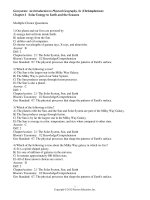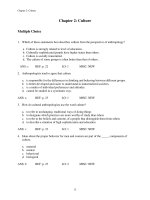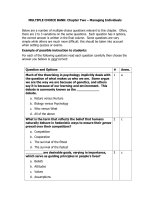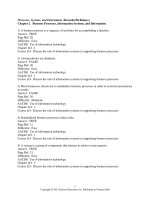Giáo trình garrett brain and behavior an introduction to biological psychology 4th edition c2015 txtbk
Bạn đang xem bản rút gọn của tài liệu. Xem và tải ngay bản đầy đủ của tài liệu tại đây (13.94 MB, 1,003 trang )
ENGAGING, RELEVANT, ACCESSIBLE
APPLIED FEATURES
OUTSTANDING PEDAGOGY
Resources That Give Instructors and Students an Edge!
To Duejean
She walks in beauty, like the night
Of cloudless climes and starry skies;
And all that’s best of dark and bright
Meet in her aspect and her eyes.. .
And on that cheek, and o’er that brow,
So soft, so calm, yet eloquent,
The smiles that win, the tints that glow,
But tell of days in goodness spent,
A mind at peace with all below,
A heart whose love is innocent!
—Lord Byron
Copyright © 2015 by SAGE Publications, Inc.
All rights reserved. No part of this book may be reproduced or utilized in any form or by any means,
electronic or mechanical, including photocopying, recording, or by any information storage and
retrieval system, without permission in writing from the publisher.
Printed in Canada.
Library of Congress Cataloging-in-Publication Data
Garrett, Bob.
Brain & behavior : an introduction to biological psychology / Bob Garrett ; contributions by Gerald
Hough and John Agnew.—Fourth edition.
pages cm
Includes bibliographical references and index.
ISBN 978-1-4522-6095–2 (pbk. : alk. paper)
ISBN 978-1-4833-1241-5 (web pdf)
1. Psychobiology—Textbooks. I. Title. II. Title: Brain and behavior.
QP360.G375 2014
612.8—dc23 2014007564
14 15 16 17 18 10 9 8 7 6 5 4 3 2 1
FOR INFORMATION:
SAGE Publications, Inc.
2455 Teller Road
Thousand Oaks, California 91320
E-mail:
SAGE Publications Ltd.
1 Oliver’s Yard
55 City Road
London, EC1Y 1SP
United Kingdom
SAGE Publications India Pvt. Ltd.
B 1/I 1 Mohan Cooperative Industrial Area
Mathura Road, New Delhi 110 044
India
SAGE Publications Asia-Pacific Pte. Ltd.
3 Church Street
#10–04 Samsung Hub
Singapore 049483
Acquisitions Editor: Vicki Knight
Editorial Assistant: Yvonne McDuffee
Production Editor: David C. Felts
Copy Editor: Amy Marks
Proofreader: Scott Oney
Typesetter: C&M Digitals (P) Ltd.
Indexer: Diggs Publication Services
Cover Designer: Candice Harman
Marketing Manager: Shari Countryman
Brief Contents
Preface
About the Author
CHAPTER 1. What Is Biopsychology?
PART I. Neural Foundations of Behavior: The Basic Equipment
CHAPTER 2. Communication Within the Nervous System
CHAPTER 3. The Organization and Functions of the Nervous System
CHAPTER 4. The Methods and Ethics of Research
PART II. Motivation and Emotion: What Makes Us Go
CHAPTER 5. Drugs, Addiction, and Reward
CHAPTER 6. Motivation and the Regulation of Internal States
CHAPTER 7. The Biology of Sex and Gender
CHAPTER 8. Emotion and Health
PART III. Interacting With the World
CHAPTER 9. Hearing and Language
CHAPTER 10. Vision and Visual Perception
CHAPTER 11. The Body Senses and Movement
PART IV. Complex Behavior
CHAPTER 12. Learning and Memory
CHAPTER 13. Intelligence and Cognitive Functioning
CHAPTER 14. Psychological Disorders
CHAPTER 15. Sleep and Consciousness
Glossary
References
Chapter-Opening Photo Credits
Author Index
Subject Index
Detailed Contents
Preface
About the Author
1. What Is Biopsychology?
The Origins of Biopsychology
Prescientific Psychology and the Mind-Brain Problem
Descartes and the Physical Model of Behavior
Helmholtz and the Electrical Brain
The Localization Issue
Nature and Nurture
The Genetic Code
Application: A Computer Made of DNA
Genes and Behavior
The Human Genome Project
Application: Beyond the Human Genome Project
Heredity: Destiny or Predisposition?
PART I. Neural Foundations of Behavior: The Basic Equipment
CHAPTER
2. Communication Within the Nervous System
The Cells That Make Us Who We Are
Neurons
Application: Targeting Ion Channels
Glial Cells
How Neurons Communicate With Each Other
Chemical Transmission at the Synapse
Regulating Synaptic Activity
Neurotransmitters
Application: Agonists and Antagonists in the Real World
Of Neuronal Codes, Neural Networks, and Computers
In the News:The Human Brain Project
CHAPTER
3. The Organization and Functions of the Nervous System
The Central Nervous System
The Forebrain
Application: The Case of Phineas Gage
The Midbrain and Hindbrain
The Spinal Cord
CHAPTER
Protecting the Central Nervous System
The Peripheral Nervous System
The Cranial Nerves
The Autonomic Nervous System
Development and Change in the Nervous System
The Stages of Development
How Experience Modifies the Nervous System
Damage and Recovery in the Central Nervous System
In the News:Is the Brain Too Fragile for Sports?
In the News:Nuclear Testing Reveals Adult Neurogenesis in Humans
Application: Mending the Brain With Computer Chips
4. The Methods and Ethics of Research
Science, Research, and Theory
Theory and Tentativeness in Science
Experimental Versus Correlational Studies
Research Techniques
Staining and Imaging Neurons
Light and Electron Microscopy
Measuring and Manipulating Brain Activity
In the News:Looking Into the Brain
Brain Imaging Techniques
Application: Scanning King Tut
In the News:Growing a Model Brain From Stem Cells
Investigating Heredity
Research Ethics
Plagiarism and Fabrication
Protecting the Welfare of Research Participants
In the News:NIH Is Retiring Most of Its Research Chimps
Gene Therapy
Stem Cell Therapy
PART II. Motivation and Emotion: What Makes Us Go
CHAPTER
5. Drugs, Addiction, and Reward
Psychoactive Drugs
Opiates
Depressants
Stimulants
Psychedelics
CHAPTER
Marijuana
In the News:Changing Attitudes Toward Marijuana
Addiction
The Neural Basis of Addiction and Reward
Dopamine and Reward
Dopamine, Learning, and Brain Plasticity
Treating Drug Addiction
Application: Preventing Addiction by Targeting the Immune System
The Role of Genes in Addiction
Separating Genetic and Environmental Influences
What Is Inherited?
Implications of Addiction Research
6. Motivation and the Regulation of Internal States
Motivation and Homeostasis
Theoretical Approaches to Motivation
Simple Homeostatic Drives
Hunger: A Complex Drive
The Role of Taste
Application: Predator Control Through Learned Taste Aversion
Digestion and the Two Phases of Metabolism
Signals That Start a Meal
Signals That End a Meal
Long-Term Controls
Application: How Nicotine and Marijuana Affect Appetite
Obesity
The Myths of Obesity
The Contributions of Heredity and Environment
In the News:How the FTO Gene Makes Us Obese
Application: The Sweet Taste of Obesity
Obesity and Reduced Metabolism
Treating Obesity
Anorexia, Bulimia, and Binge Eating Disorder
Environmental and Genetic Contributions
The Role of Serotonin, Dopamine, and Cannabinoids
CHAPTER
7. The Biology of Sex and Gender
Sex as a Form of Motivation
Arousal and Satiation
CHAPTER
The Role of Testosterone
Brain Structures and Neurotransmitters
Odors, Pheromones, and Sexual Attraction
Application: Of Love and Bonding
The Biological Determination of Sex
Chromosomes and Hormones
Prenatal Hormones and the Brain
Gender-Related Behavioral and Cognitive Differences
Some Demonstrated Male–Female Differences
Origins of Male–Female Differences
Biological Origins of Gender Identity
Gender Identity Reversal
46 XY Difference in Sexual Development
46 XX Difference in Sexual Development
Cognitive and Behavioral Effects
Ablatio Penis: A Natural Experiment
Application: Sex, Gender, and Sports
In the News:Who Chooses a Child’s Sex?
Sexual Orientation
The Social Influence Hypothesis
Genetic and Epigenetic Influences
Prenatal Influences on Brain Structure and Function
Social Implications of the Biological Model
8. Emotion and Health
Emotion and the Nervous System
Autonomic and Muscular Involvement in Emotion
The Emotional Brain
The Prefrontal Cortex
Application: Why I Don’t Jump Out of Airplanes
The Amygdala
Hemispheric Specialization in Emotion
Stress, Immunity, and Health
Stress as an Adaptive Response
Negative Effects of Stress
In the News:Keeping Odd Hours Could Make You Sick
Application: One Aftermath of 9/11 Is Stress-Related Brain Damage
Social, Personality, and Genetic Factors
Pain as an Adaptive Emotion
Biological Origins of Aggression
Hormones and Aggression
The Brain’s Role in Aggression
CHAPTER
Neurotransmitters and Aggression
Application: Neurocriminology, Responsibility, and the Law
Heredity and Environment
PART III. Interacting With the World
9. Hearing and Language
Hearing
The Stimulus for Hearing
The Auditory Mechanism
Frequency Analysis
Application: Restoring Hearing
Locating Sounds With Binaural Cues
Application: I Hear a Tree Over There
Language
Broca’s Area
Wernicke’s Area
The Wernicke-Geschwind Model
Reading, Writing, and Their Impairment
Mechanisms of Recovery From Aphasia
A Language-Generating Mechanism?
In the News:Learning Language Starts Before Birth
Language in Nonhumans
Neural and Genetic Antecedents
In the News:The Link Between Human Language and Birdsong
CHAPTER
10. Vision and Visual Perception
Light and the Visual Apparatus
The Visible Spectrum
The Eye and Its Receptors
Pathways to the Brain
Application: Restoring Lost Vision
Color Vision
Trichromatic Theory
Opponent Process Theory
A Combined Theory
Color Blindness
Form Vision
Contrast Enhancement and Edge Detection
Hubel and Wiesel’s Theory
CHAPTER
Spatial Frequency Theory
The Perception of Objects, Color, and Movement
The Two Pathways of Visual Analysis
Disorders of Visual Perception
The Problem of Final Integration
Application: When Binding Goes Too Far
11. The Body Senses and Movement
The Body Senses
Proprioception
The Skin Senses
The Vestibular Sense
The Somatosensory Cortex and the Posterior Parietal Cortex
Pain and Its Disorders
Application: Treating Pain in Limbs That Aren’t There
Movement
The Muscles
The Spinal Cord
The Brain and Movement
In the News:Coordinating Artificial Limbs
Disorders of Movement
In the News:Curing Parkinson’s in a Dish
PART IV. Complex Behavior
CHAPTER
12. Learning and Memory
Learning as the Storage of Memories
Amnesia: The Failure of Storage and Retrieval
Application: The Legacy of HM
Mechanisms of Consolidation and Retrieval
Where Memories Are Stored
Two Kinds of Learning
Working Memory
Brain Changes in Learning
Long-Term Potentiation
How LTP Happens
Neural Growth in Learning
Consolidation Revisited
Changing Our Memories
Application: Total Recall
CHAPTER









